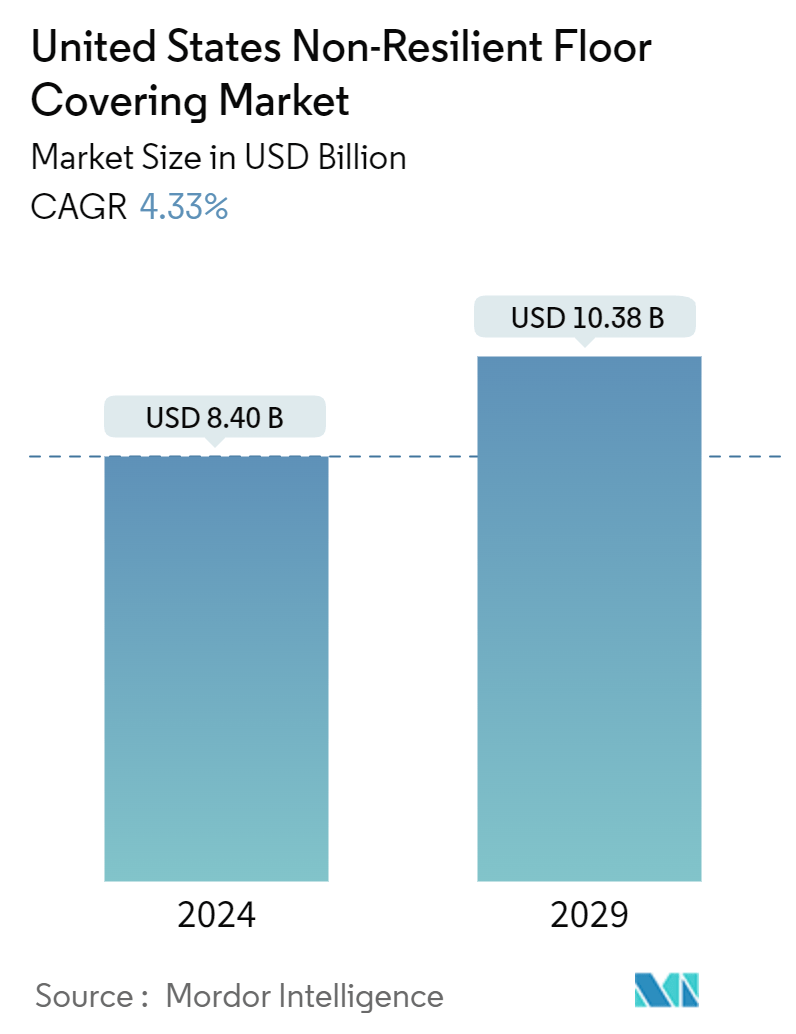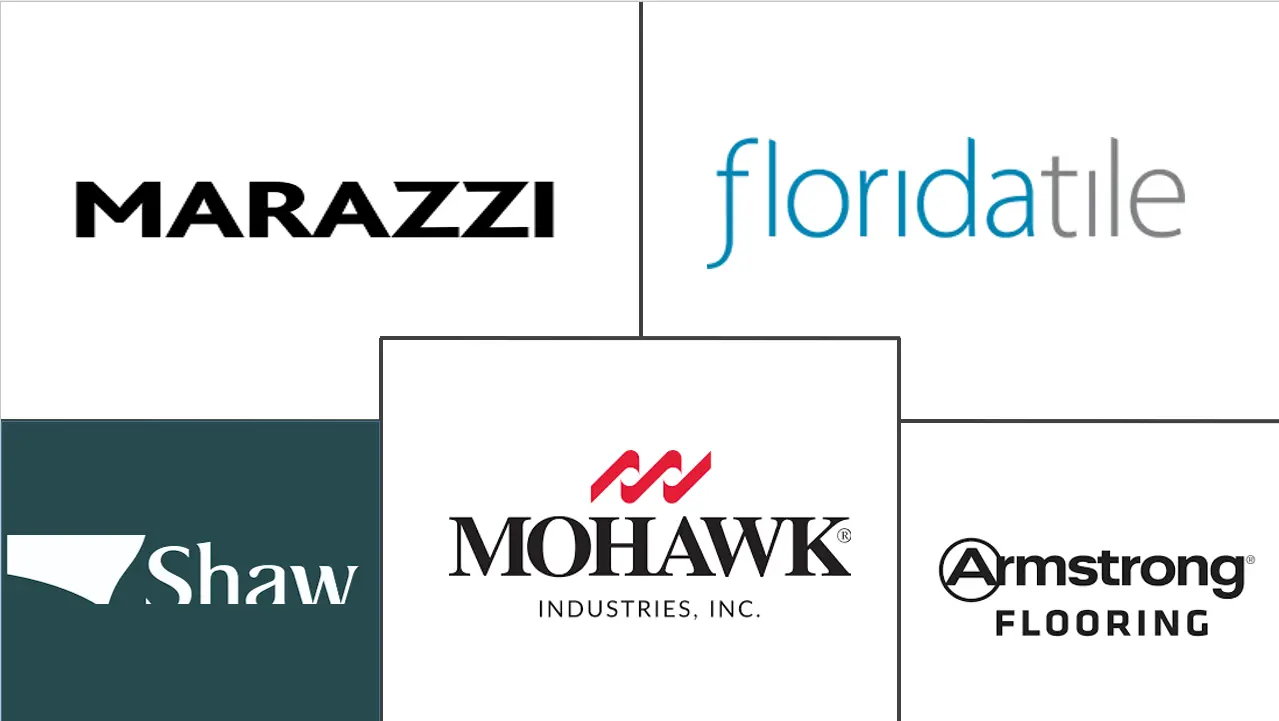Market Size of United States Non-Resilient Floor Covering Industry

| Study Period | 2020 - 2029 |
| Base Year For Estimation | 2023 |
| Market Size (2024) | USD 8.40 Billion |
| Market Size (2029) | USD 10.38 Billion |
| CAGR (2024 - 2029) | 4.33 % |
| Market Concentration | Medium |
Major Players
*Disclaimer: Major Players sorted in no particular order |
United States Non-Resilient Floor Covering Market Analysis
The United States Non-Resilient Floor Covering Market size is estimated at USD 8.40 billion in 2024, and is expected to reach USD 10.38 billion by 2029, growing at a CAGR of 4.33% during the forecast period (2024-2029).
The United States is the second-largest floor-covering market in the world and is forecasted to register moderate growth during the forecast period. The growing construction market, especially residential construction, is forecasted to drive the market. It is one of the growing and highly demanded flooring markets as people prefer the combo of natural and man-made flooring from technology-driven and new designs for which non-resilient flooring is appropriate. The consumer much prefers the non-resilient flooring market because it's easier and cheaper to maintain as these floors are glued down to the concrete leading to an increase in demand for non-resilient flooring.
With rising investment and projects, especially towards housing, building, and construction, the non-resilient flooring industry is witnessing an increase in demand. Growing public interest and government initiatives toward buying new houses is further enhancing the overall market demand for non-resilient flooring during the forecast period.
The United States non-resilient flooring market offers a huge variety of newly innovated designs with hand paintings or many digital artworks in different colours and fitting types, made up with new technologies and increased longevity. In the non-resilient flooring market of the United States, the ceramic, stone, wood, laminate, and concrete segment has emerged as the most prominent category.
Specifically, the segment comprising these materials holds the largest share in the non-resilient flooring market in the current year. These flooring options have gained significant popularity due to their durability, aesthetics, and versatility, meeting the diverse needs of consumers.
One of the major advantages of having concrete floors is they are completely customizable, and colour choices, textures, patterns, and finish options combine for limitless design possibilities. In addition, concrete floors are extremely durable, long-lasting, and easy to maintain. Therefore, due to the wide variety of choices it gives, the concrete flooring demand is expected to grow, and owing to this, the non-resilient market will also rise.
United States Non-Resilient Floor Covering Industry Segmentation
The United States non-resilient flooring market refers to the floors that have hard surfaced flooring material such as stone, brick, slate, or ceramic tile and are used in buildings that can assist in determining the age of a structure, including bamboo, brick, concrete, stone, slate, and a wide variety of wood products.
The United States non-resilient floor covering market is segmented by product, by end-user, and by distribution channel. By product, the market is sub-segmented into ceramic tiles flooring, stone tiles flooring, wood flooring, laminate tiles flooring, and others. By end-user, the market is sub-segmented into residential and commercial, and by distribution channel, the market is sub-segmented into online and offline.
The report offers the market sizes and forecasts in value (USD) for all the above segments."
| By Product Type | |
| Ceramic Tiles Flooring | |
| Stone Tiles Flooring | |
| Laminate Tiles Flooring | |
| Wood Tiles Flooring | |
| Other Product Types |
| By End-User | |
| Residential | |
| Commercial |
| By Distribution Channel | |
| Online | |
| Offline |
United States Non-Resilient Floor Covering Market Size Summary
The United States non-resilient floor covering market is poised for steady growth, driven by the expanding construction sector, particularly in residential projects. As the second-largest floor covering market globally, the U.S. is experiencing increased demand for non-resilient flooring due to its combination of natural and man-made materials, which appeal to consumers seeking modern, technology-driven designs. The market benefits from the ease of maintenance and cost-effectiveness of non-resilient flooring, which is typically glued down to concrete. This flooring type is gaining traction as public interest and government initiatives encourage new housing developments, further boosting market demand. The market offers a wide array of innovative designs, with ceramic, stone, wood, laminate, and concrete segments leading in popularity due to their durability, aesthetics, and versatility.
Technological advancements have significantly transformed the non-resilient floor covering industry, introducing new products that emphasize innovation and cater to diverse consumer needs. These advancements have led to the development of features such as water resistance and hypoallergenic properties, making non-resilient flooring an attractive option for those with allergies or respiratory concerns. The market is highly competitive, with numerous domestic and international players leveraging technology to enhance their product offerings. Companies like Shaw Industries and Mohawk Industries are at the forefront, focusing on technological innovations and strategic partnerships to strengthen their market position. The ongoing expansion of the construction industry, coupled with these technological advancements, is expected to sustain the growth of the non-resilient floor covering market in the United States over the forecast period.
United States Non-Resilient Floor Covering Market Size - Table of Contents
-
1. MARKET INSIGHTS AND DYNAMICS
-
1.1 Market Overview
-
1.2 Market Drivers
-
1.3 Market Restraints
-
1.4 Industry Value Chain Analysis
-
1.5 Insights on impact of technology and innovation in the Market
-
1.6 Porter's Five Forces Analysis
-
1.6.1 Threat of New Entrant
-
1.6.2 Bargaining Power of Buyer/ Consumer
-
1.6.3 Bargaining Power of Suppliers
-
1.6.4 Threat of Substitute Product
-
1.6.5 Intensity of Competitive Rivalry
-
-
1.7 Impact of COVID-19 on the market
-
-
2. MARKET SEGMENTATION
-
2.1 By Product Type
-
2.1.1 Ceramic Tiles Flooring
-
2.1.2 Stone Tiles Flooring
-
2.1.3 Laminate Tiles Flooring
-
2.1.4 Wood Tiles Flooring
-
2.1.5 Other Product Types
-
-
2.2 By End-User
-
2.2.1 Residential
-
2.2.2 Commercial
-
-
2.3 By Distribution Channel
-
2.3.1 Online
-
2.3.2 Offline
-
-
United States Non-Resilient Floor Covering Market Size FAQs
How big is the United States Non-Resilient Floor Covering Market?
The United States Non-Resilient Floor Covering Market size is expected to reach USD 8.40 billion in 2024 and grow at a CAGR of 4.33% to reach USD 10.38 billion by 2029.
What is the current United States Non-Resilient Floor Covering Market size?
In 2024, the United States Non-Resilient Floor Covering Market size is expected to reach USD 8.40 billion.

